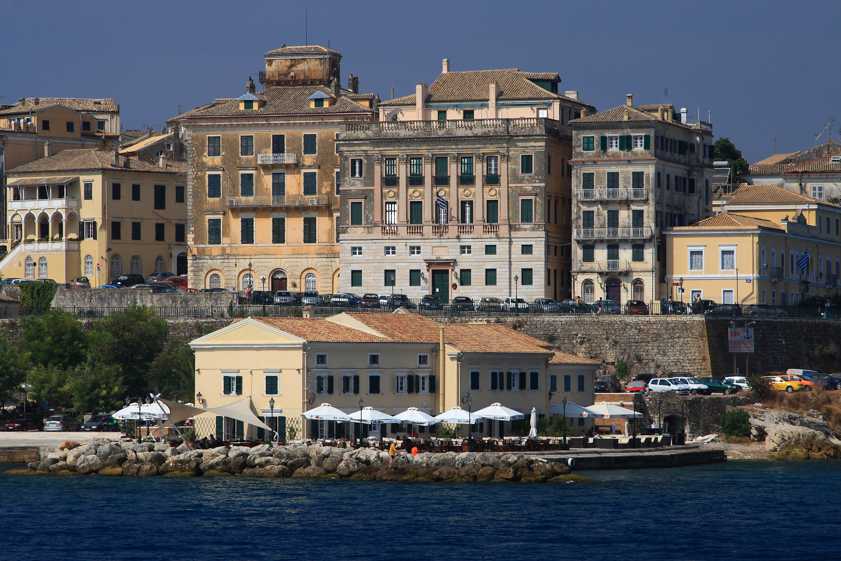CORFU OLD TOWN
Imbued with Venetian grace and elegance
Some History & Fun Facts
Influenced by many cultures

Influenced by many cultures
From Venetians to French and British
When approached by sea one gets a glorious impression of the town’s dense and impressive architecture which has been preserved, alive and substantially unaltered, until the present day. Largely built by the Venetians with important additions in time by other major European countries.
Corfu holds some majestic architecture!
ARCHITECTURE
History meets culture
Safeguarding Cultural Landscapes
UNESCO
Famous Liston
Liston in Spianada
Corfu became a cradle of science and a culture synonymous in importance to other European cities. The Liston, for example, strongly evokes the “Rue de Rivoli” of Paris which the French began to build in 1807 and is a typical example of European architecture in that era. The prevailing theory is that only those included in the Libro d’Oro could walk here. The personal signature of nobles was a precondition to enter the closed for many Liston area, where only the elite and privileged could enjoy a walk or a drink. While the distinct cosmopolitan flair still remains everyone can a drink and the customary evening stroll along the Liston just around the corner from Sopra Mura.
Protector of the island
Saint Spyridon
Music tradition of Corfu

Music is our thing
Corfu has a strong music tradition which includes philharmonic orchestras, choirs and a well-respected music department at the Ionian University. There are 17 brass bands in Corfu four of which are based in Corfu Town and the rest in various villages with a total of membership of around 2000 musicians. It is estimated that more people play an instrument per capita than anywhere else in Europe. Easter in Corfu town is a huge event with music being instrumental so to speak, in creating a very unique ambience. Sopra Mura has a front row seat in all the Easter celebrations in Corfu.

Theatre of Corfu
The Municipal Theatre of Corfu was the main theatre and opera house in Corfu, Greece, from 1902 to 1943 when sadly it was destroyed during a WW2 air raid. During its 41-year history it was one of the premier theatres and opera houses in Greece, and as the first theatre in Southeastern Europe, it contributed to the Arts and to the history of the Balkans and of Europe. It is said that if a play was applauded in Corfu it would surely do well elsewhere.


1| Sotto Mura
1| Built into the northern walls of Corfu Town called Mouragia is a small cave like church dedicated to the Virgin Mary. The single step into it is almost at sea level and its original name was Limniotissa or Sotto Mura meaning the one beneath the walls in Italian. One can still visit the church today beneath Sopra Mura which is where the name of this luxury town house has been inspired from: above the walls rather than bellow.

2| Corfu Like Mermaid
2| If you look at the satellite image of Corfu island it looks like a huge mermaid like being looking up towards the north west of the island with long hair flowing out behind her towards the north east. Her tails starts around the height of Corfu Town, the front of her knees are at Korission Lake and the tip of her tail is in Lefkimmi. With a little bit of imagination you too will be able to see The Mermaid Island©.

3| First in Corfu
3| The first Greek parliament was created in Corfu, the first Greek Prime minister came from Corfu and the Greek national anthem was written in Corfu. The Ionian University was the first university in Greece, the first Psychiatric Hospital and Prison were all in Corfu too. The first tennis club in Greece also comes from Corfu, founded by the English in 1896 as well as a very first modern opera and theatre house of Greece. That’s a lot of firsts!

4| The Garden of Gods
4| On the island you can find about 6,000 different species of herbs and flowers, of which there are rarely encountered elsewhere such as 55 species of wild orchids. The oldest Olive Tree is called Evdokia and is estimated to be between 1086 and 1200 years old in the village of Strongili. The island is famous for its large amounts of olive trees with an estimated 4 million of them both wild and cultivated.
Ask Your Queries
Ask Your Queries
Click the icon above if you wish to contact us through our website.